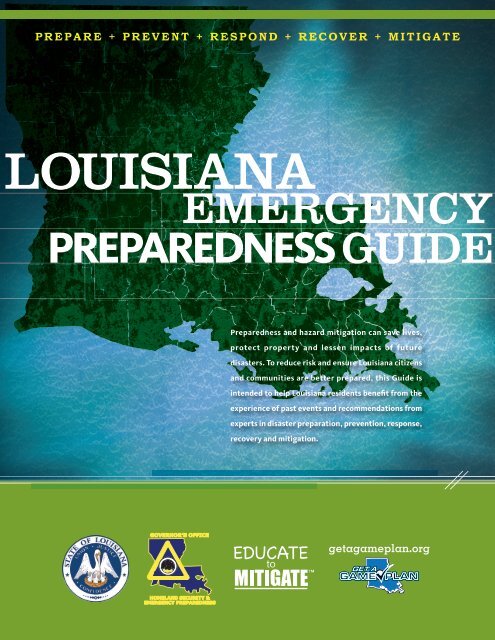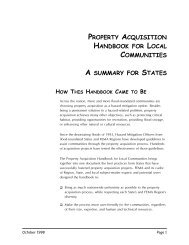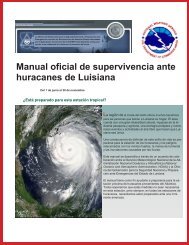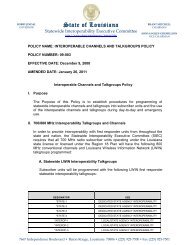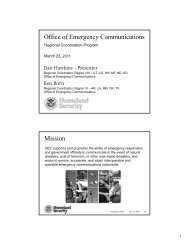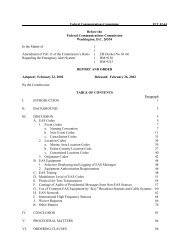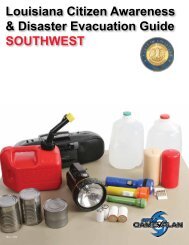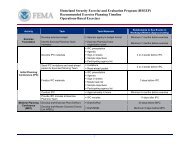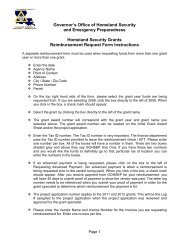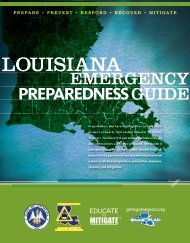Louisiana Emergency Preparedness Guide - Governor's Office of ...
Louisiana Emergency Preparedness Guide - Governor's Office of ...
Louisiana Emergency Preparedness Guide - Governor's Office of ...
Create successful ePaper yourself
Turn your PDF publications into a flip-book with our unique Google optimized e-Paper software.
PREPARE + PREVENT + RESPOND + RECOVER + MITIGATE[ 4 ]High Wind+ TornadoTornadoes are nature’s most violent storms. Spawnedfrom powerful thunderstorms, tornadoes can causefatalities and devastate a neighborhood in seconds.Some <strong>of</strong> the danger signs <strong>of</strong> a tornado are a dark, <strong>of</strong>tengreenish sky; large hail; a large, dark, low-lying cloud(particularly if rotating); and loud roaring, similar to afreight train.Hurricanes, no matter how weak, are dangerous. The combination <strong>of</strong> storm surge, wind andother contributing factors determines a hurricane’s destructive power. To compare the disasterpotential <strong>of</strong> sustained wind, emergency forces utilize the Saffir-Simpson scale <strong>of</strong> wind speedsto help them predict potential hazards. The National Oceanic and AtmosphericAdministration’s (NOAA) forecasters use the Saffir-Simpson Scale.CATEGORY 1CATEGORY 2 CATEGORY 3 CATEGORY 4 CATEGORY 574 – 95 mph 96 – 110 mph 111 – 130 mph 131 – 155 mph 155+ mphHurricane Isaac had Category 1 sustainedwinds but extensive damage from floodingon I-10 in LaPlace.Graphic courtesy <strong>of</strong> Lafayette Utilities SystemFlooding + IcePREPAREMost people in <strong>Louisiana</strong> associate hurricanes withdevastating winds and storm surge. While strong windsand high storm surges do cause a tremendous amount <strong>of</strong>coastal destruction, flooding resulting from a hurricane canoccur hundreds <strong>of</strong> miles from the coast. Inland floodingthroughout coastal, central and north <strong>Louisiana</strong> cancause severe damage after a hurricane makes landfall andas the remaining weather system moves through the State.Since 1970, inland flooding has been responsible for morethan half <strong>of</strong> all deaths associated with tropical storms andhurricanes in the United States.Flooding can occur as a result <strong>of</strong> other weather events.People across the State can be at risk from floodingcaused by heavy rains. People in central and north<strong>Louisiana</strong> may be at risk from flooding caused bymelting snow and ice.Winter storms accompanied by dangerously lowtemperatures and sometimes by strong winds, icing,sleet and freezing rain can also be a danger. Winterstorms can knock out heat, power and communicationsservices to your home or <strong>of</strong>fice, sometimes for days at atime. Icy conditions and extreme cold can immobilize anentire region.FOR MORE INFORMATION VISIT:getagameplan.org and ready.govTrimming limbs that extend overbuildings in advance <strong>of</strong> ice storms is animportant mitigation measure.
[ 5 ]PREPARE + PREVENT + RESPOND + RECOVER + MITIGATE<strong>Emergency</strong> SupplyChecklistFOOD (3-DAY SUPPLY)q fruit: canned, dried, roll-upsq meats: canned or driedq vegetables: cannedq powdered milkq juices: canned or bottledq water: bottledq peanut butterq crackersq soup: cannedq high-energy barsBABY SUPPLIESq diapers, baby wipesq milk, food, formulaq clothesq disposable bottles and linersq blankets, sheets, bed linersq medicationsq portable cribq toysPERSONAL ITEMSq soap, toothbrush, deodorantq towels and washclothsq sewing kitq shampooq feminine hygiene itemsq shaving kitq mirrorq eyeglasses and contact lensesq special items needed for the elderlyand disabledCHILDREN’S SUPPLIESq quiet toysq coloring booksq crayonsq puzzlesq booksq CD/MP3 playerq extra batteriesSANITARY ITEMSq portable toiletq plastic garbage bagsq paper towels, toilet paperq liquid detergentq disinfectantCLOTHING + BEDDINGq rain gearq sleeping bags, blankets and pillowsq extra shoes and work bootsq extra clothesCOMMUNICATION EQUIPMENTq battery-operated radioq extra batteriesq NOAA weather radioq cellular phone and chargerq non-cordless phoneLIGHTINGq waterpro<strong>of</strong> flashlightsq battery-powered lanternq extra batteriesCLEANUP SUPPLIESq washing detergentsq mops, brooms, etc.q buckets, extra hoseq old blankets, towels, ragsq large plastic garbage bags and tiesq rubber glovesq bleach, disinfectantsq camera to photograph homebefore cleanup
PREPARE + PREVENT + RESPOND + RECOVER + MITIGATE[ 8 ]PetsDISASTER PREPAREDNESS FOR PETSMake sure you have:• Food and water for at least three (3) days foreach pet.• Food and water bowls and a manual can opener.• Depending on the pet, pack litter and litter boxor newspapers, paper towels, plastic trash bags,grooming items and household bleach.• Don’t forget pet medications and medical recordsstored in a waterpro<strong>of</strong> container, a first aid kit anda pet first aid book.• Sturdy leashes, harnesses and carriers to transportpets safely and to ensure that your pets cannotescape. A carrier should be large enough for theanimal to stand comfortably, turn around and liedown. Your pet may have to stay in the carrierfor hours. Be sure to have a secure carrier withno loose objects. Include blankets or towels forbedding and warmth and other special items.• Bring pet toys and the pet’s bed, if you can easilytake it, to reduce stress.• Current photos and descriptions <strong>of</strong> your pets tohelp others identify them in case you and your petsbecome separated, and to prove that they are yours.• Make a copy <strong>of</strong> feeding schedules, medicalconditions, behavior problems and the name andtelephone number <strong>of</strong> your veterinarian in caseyou have to board your pets or place them infoster care.• The <strong>Louisiana</strong> Department <strong>of</strong>Agriculture and Forestry and itsnon-governmental partnerswork year around to supportlocal response to disasters. Animalshelters may be available through yourParish evacuation plan; contact your local <strong>Office</strong> <strong>of</strong>Homeland Security and <strong>Emergency</strong> <strong>Preparedness</strong>.The location <strong>of</strong> your evacuation destination mayor may not accept pets, so call ahead and check.All hazards disaster preparedness information isavailable at ldaf.state.la.us.• Remember, animal ownership is a responsibility!Be ready to take care <strong>of</strong> your whole family.FOR MORE INFORMATION ON DISASTERPREPAREDNESS FOR YOUR PETS VISIT:getagameplan.org/planFamilyStp02.htm or the<strong>Louisiana</strong> Society for Prevention <strong>of</strong> Cruelty to Animals(LA SPCA) website LA-SPCA.org or call 504-368-5191PREPARE
[ 9 ]PREPARE + PREVENT + RESPOND + RECOVER + MITIGATEGet a Game Plan+ Apps + LinksThe Governor’s <strong>Office</strong> <strong>of</strong> Homeland Security and<strong>Emergency</strong> <strong>Preparedness</strong> (GOHSEP) hosts an energeticweb-based education and information portal designed tohelp <strong>Louisiana</strong> citizens prepare for, monitor and respondto disasters.The website is maintained by GOHSEP and providesinformation about hazard mitigation measures, disasterpreparation, ways to respond to an emergency andhow to recover from weather-related disasters, aswell as other hazards. It helps you develop a simple,yet successful game plan for your family, should anemergency occur, in order to keep you and yourfamily safe.facebook.com/gohsepyoutube.com/user/GOHSEPtwitter.com/gohsepGETAGAMEPLAN.ORGThe app:• Identifies places to evacuate and includes petsheltering and special needs information.• Provides critical information and checklists tohelp you create a personal evacuation plan.• Includes evacuation maps for viewing in theevent <strong>of</strong> an emergency or natural disaster withadditional panels for routes and an informationicon to display or email more detailed routinginformation.• Lists important numbers needed in the event <strong>of</strong>an emergency are listed along with the abilityto place a call, text and create a contact for laterretrieval on an iPhone. FOR MORE INFORMATION VISIT:getagameplan.orgVisit iTunes to download.Visit redcross.org/prepare/mobile-apps for descriptions.Visit iTunes or Google Play to download.FIRST AIDHURRICANES FINDING TORNADOES WILDFIRESHELTERS
PREPARE + PREVENT + RESPOND + RECOVER + MITIGATE[ 10 ]ALERT FMFor a description go to alertfm.com/products/mobileapplicationsVisit iTunes or Google Play to download.• Functions like a weather radio, but with unique localalerts from emergency <strong>of</strong>ficials.• Offers simple functionality. The user enters a“home” zip code upon launching the app. Thisconnects the user with State and local emergencymanagers on the network.FEMAFor a description go to fema.gov/smartphone-appVisit iTunes, Google Play or Blackberry World to download.KNOW YOUR PLANBy Insurance Information InstituteThe FEMA app contains disaster safety tips, interactive lists forstoring your emergency kit and emergency meeting locationinformation, and a map with open shelters and open FEMADisaster Recovery Centers (DRCs).Visit iTunes to download.Use Know Your Plan – listed as “Your Plan” in iTunes – to beprepared when disaster strikes! In the event <strong>of</strong> hurricanes,wildfires, earthquakes, tornadoes, severe cold, evacuations,this app helps you plan ahead to better protect yourself, yourfamily, your home and your pets. Get started by using thepreloaded checklists to learn about important mitigation andpreparation steps, or create your own lists from scratch. Youcan set due dates, chart your progress, include notes withyour tasks, and share your checklists with family and friends.Get organized now so you can be ready for what may come.PREPAREHEALTHVAULTVisit HealthVault.com to discover apps that let you:• Keep all <strong>of</strong> your health records in one place that’s organizedand available to you online.• Keep track <strong>of</strong> medications, health history, conditions andillnesses, allergies, x-rays and scans.
[ 11 ] PREPARE + PREVENT + RESPOND + RECOVER + MITIGATEBusiness PreparationPREPARE YOUR BUSINESS FOR A DISASTER• Document employee roles and responsibilitiesduring a crisis situation.• Conduct a drill to make sure your staffunderstands their roles and to test youremergency plan and continuity systems.• Ask your vendors what their disasterpreparedness plans are so you will know how yoursupply chain will be protected.• Ensure vital records are protected.>> Review your <strong>of</strong>f-site backup record storage.>> Place irreplaceable paperwork and digitalstorage media in a firepro<strong>of</strong>, waterpro<strong>of</strong> box.Consider having a “Go Box” with:• A hard copy <strong>of</strong> your emergency plan.• A copy <strong>of</strong> a primary, secondary and out-<strong>of</strong>-areacontact information for employees and keystakeholders.• A copy <strong>of</strong> insurance policies and agent contactinformation.• A copy <strong>of</strong> contact information for emergencyvendors (contractors, plumbers, electricians, moldremediation, etc.).• Laptops and portable backup media for criticalbusiness information.• Important documents (such as finance recordsand an assets inventory).• General <strong>of</strong>fice supplies and special forms that youmay need to do business at an alternate location.SECURE THE PREMISES• Move computers and copiers away from largewindows.• Cover and elevate inventory.• Anchor large equipment, cabinets and shelves towalls or floors.• Move or store equipment, furniture and valuablefiles on the upper level <strong>of</strong> multistory buildings.>> OR place equipment on concrete blocksat least 12 inches above projected floodelevations.• Cover doors and windows.THE NATIONAL FLOOD INSURANCEPROGRAM (NFIP)fema.gov/national-flood-insurance-programAlmost 40 percent <strong>of</strong> small businesses never reopentheir doors following a disaster because just a fewinches <strong>of</strong> water can cause tens <strong>of</strong> thousands <strong>of</strong> dollarsin damage. Between 2006 and 2010, the averagecommercial flood claim amounted to just over $85,000.Flood insurance is the best way to protect yourself fromdevastating financial loss. Find the flood risk for yourbusiness now using our One-Step FloodRisk Pr<strong>of</strong>ile at floodsmart.gov.Flood insurance is available to homeowners, renters,condo owners/renters and commercial owners/renters.Costs vary depending on how much insurance ispurchased, what it covers and the property’s flood risk.Coverage for your building and contents is available. Talkto your agent today about insuring your business and itscontents. Typically, there’s a 30-day waiting period fromdate <strong>of</strong> purchase before your policy goes into effect. Thatmeans now is the best time to buy flood insurance.The <strong>Louisiana</strong> Business <strong>Emergency</strong> Operations Center(LA BEOC) supports the coordination <strong>of</strong> activities andresources <strong>of</strong> businesses and volunteer organizationswith the State’s <strong>Emergency</strong> Operations Center (SEOC)during emergencies. The LA BEOC provides situationalawareness and identifies critical supply chains <strong>of</strong>goods and services likely to be needed in response to adisaster or emergency. To find out about the benefits <strong>of</strong>registering with the LA BEOC go to labeoc.org.Reentering an area may be difficult following a disaster.Access control is carried out using a tiered approach.For information go to lsp.org, click on Alerts, then on<strong>Emergency</strong> Information and then <strong>Louisiana</strong> StatewideCredentialing/Access Program. Also be sure to checkwith your Parish to see if they have specific reentryrequirements and permits.FOR MORE INFORMATION ON BUSINESSPREPAREDNESS AND DISASTER PLANNING VISIT:getagameplan.org/planBusiness.htmTo download a copy <strong>of</strong> the small-business disasterpreparedness guide From Risk To Resiliency go togohsep.la.gov/publications.aspxDownload the GET A BUSINESS PLANapp on iTunes.ready.gov/planningfema.gov/protect-your-property-or-businessdisasterreadyrating.orgdisastersafety.org/open-for-business
PREPARE + PREVENT + RESPOND + RECOVER + MITIGATE[ 12 ]see it.suspect it.REPORT IT.PreventionHOMELAND SECURITY BEGINS WITHHOMETOWN SECURITYIf you see something suspicious taking place, reportthat behavior or activity to local law enforcement.Factors such as race, ethnicity, national origin or religiousaffiliation alone are not suspicious. For that reason,the public should report only suspicious behavior andsituations (e.g., an unattended backpack in a public placeor someone trying to break into a restricted area) ratherthan beliefs, thoughts, ideas, expressions, associations orspeech unrelated to terrorism or other criminal activity.Only reports that indicate relevant criminal activity willbe shared with Federal partners.Fusion Centers manage the flow <strong>of</strong>information and intelligence acrosslocal, State, Tribal and Federal agencies.In <strong>Louisiana</strong>, the Fusion Center iscoordinated by State Police (LSP) throughthe Department <strong>of</strong> Public Safety (DPS) andconsists <strong>of</strong> a number <strong>of</strong> law enforcement,public safety and governmental partners. The public plays avital role in providing information about potential acts <strong>of</strong>terrorism and terrorist organizations to these centers. Visitthe la-safe.org web site to learn more about the <strong>Louisiana</strong>State Analytical and Fusion Exchange (LA-SAFE).LOUISIANA’S PRIMARY DOMESTIC +INTERNATIONAL CONCERNS• Cyber crime• Drug trafficking organizations• Gangs• Immigration smuggling• Sexual predators• Suspicious activity• Transnational + national criminal organizations• TerrorismTWO (2) WAYS TO REPORT SUSPICIOUS ORCRIMINAL ACTIVITYThere are two (2) ways to report suspicious or criminalactivity:• Contact <strong>Louisiana</strong> State Police (LSP) SuspiciousActivity Hotline: 1-800-434-8007 or visit lsp.org/help.html.• Use the See Send app.Please remember, in case <strong>of</strong> an emergency, always dial9-1-1.SEE SEND APPThe See Something Send Somethingapp is the preeminent nationwidesuspicious activity reporting (SAR)tool for citizens to help in the fightagainst terrorism. See Something SendSomething has information to educate you on what tolook for and when to submit suspicious activity reportsalong with how to receive important alerts. The SAR toolconnects you to a nationwide network <strong>of</strong> IntelligenceCenters by routing tips to the correct center for analysis.Visit iTunes or Google Play to download the SEE SENDapp. It’s FREE.PREVENT
[ 15 ]PREPARE + PREVENT + RESPOND + RECOVER + MITIGATE<strong>Louisiana</strong> <strong>Emergency</strong> Evacuation MapFor road closures, call the <strong>Louisiana</strong> Department <strong>of</strong> Transportationand Development (DOTD) at 877-4LA-DOTD (visit online at 511la.org),or <strong>Louisiana</strong> State Police at 800-469-4828 (visit online at lsp.org).PHASE I (RED)50 hours before onset <strong>of</strong> tropicalstorm force winds. Set evacuationsinclude areas south <strong>of</strong> IntracoastalWaterway. These areas are outsideany levee protection system andare vulnerable.PHASE II (ORANGE)40 hours before onset <strong>of</strong> tropicalstorm force winds for south <strong>of</strong>I-10, which are levee protected butremain vulnerable.PHASE III (YELLOW)30 hours before onset <strong>of</strong> tropical stormforce winds for areas on the east bank <strong>of</strong>the Mississippi River in the New Orleansmetropolitan area, which are withinlevee protection system but remainvulnerable.
PREPARE + PREVENT + RESPOND + RECOVER + MITIGATE[ 16 ]<strong>Louisiana</strong> Parishes + Homeland Security+ <strong>Emergency</strong> <strong>Preparedness</strong> InformationY NT DISASTER RESPONSE INFORMATIONEMERGENCYSHERIFF’SPARISH MANAGEMENT WEBSITE OFFICEAcadia 337-783-4357 appj.org 337-788-8700Allen 337-639-4353 — 337-639-4353Ascension 225-621-8360 ascensionparish.net 225-621-8300Assumption 985-369-7386 assumptionoep.com 985-369-2912Avoyelles 318-253-4000 avoypj.org 318-253-4000Beauregard 337-460-5442 — 337-463-3281Bienville 318-263-2019 bienvilleparish.org 318-263-2215Bossier 318-425-5351 cbohsep.org 318-965-2203Caddo 318-425-5351 cbohsep.org 318-675-2170Calcasieu 337-721-3800 cppj.net 337-491-3700Caldwell 318-649-3764 — 318-649-2345Cameron 337-775-7048 parish<strong>of</strong>cameron.net 337-775-5111Catahoula 318-744-5697 catahoulaparish.org 318-744-5411Claiborne 318-927-9118 claiborneone.org 318-927-2011Concordia 318-336-5231 conppj.org 318-336-5231De Soto 318-872-1877 dpso.org 318-872-3956East Baton Rouge 225-389-2100 brgov.com 225-389-5074East Carroll 318-559-2256 — 318-559-2800East Feliciana 225-683-1014 — 225-683-3313Evangeline 337-363-3267 evangelineparishpolicejury.com 337-363-2161Franklin 318-435-6247 — 318-435-4505Grant 318-627-3041 — 318-627-3261Iberia 337-369-4427 iberiaparishgovernment.com 337-369-3711Iberville 225-687-5140 ibervilleparish.com 225-687-5100Jackson 318-259-2361, ext 204 jacksonparishpolicejury.org 318-259-9021Jefferson Davis 337-824-3850 jdps.org 337-824-3850Jefferson 504-349-5360 jeffparish.net 504-363-5500Lafayette 337-291-5075 lafayetteohsep.org 337-232-9211Lafourche 985-537-7603 lafourchegov.org 985-449-2255La Salle 318-992-2151 — 318-992-2151Lincoln 318-513-6202 — 318-251-5111Livingston 225-686-3066 lpoep.org 225-686-3996Madison 318-574-6911 — 318-574-1833Morehouse 318-239-8062 mpso.net 318-281-4141Natchitoches 318-238-7555 nppj.org 318-352-6432Orleans 504-658-8700 nola.gov 504-658-5858 (NOPD)Ouachita 318-322-2641 — 318-329-1200Plaquemines 504-274-2476 plaqueminesparish.com 504-564-2525Pointe Coupee 225-694-3737 pcpso.org 225-694-3737Rapides 318-445-5141 rppj.com 318-473-6700Red River 318-932-5981 — 318-932-4221Richland 318-728-0453 — 318-728-2071Sabine 318-256-2675 — 318-256-9241St. Bernard 504-278-4268 sbpg.net 504-271-2501St. Charles 985-783-5050 stcharlesparish-la.gov 985-783-6807St. Helena 225-222-3544 sthelenaparish.la.gov 225-222-4413St. James 225-562-2364 stjamesla.com 225-562-2200St. John the Baptist 985-652-2222 sjbparish.com 985-652-9513St. Landry 337-948-7177 stlandryparishgovernment.org 337-948-6516St. Martin 337-394-2800 stmartinohsep.org 337-394-3071St. Mary 337-828-4111, ext 135 stmaryohsep.org 985-384-1622St. Tammany 985-898-2359 stpgov.org 985-898-2338Tangipahoa 985-748-3211 tangisafe.com 985-345-6150Tensas 318-766-3992 — 318-766-3961Terrebonne 985-873-6357 tohsep.com 985-876-2500Union 318-368-3124 unionsheriff.com 318-368-3124Vermilion 337-898-4308 vermilionparishpolicejury.comVernon 337-238-0815 vppjla.com 337-238-1311Washington 985-839-0434 washingtonparishalerts.org 985-839-3434Webster 318-371-1128 websterparishla.org 318-377-1515West Baton Rouge 225-346-1577 wbrparish.org 225-343-9234West Carroll 318-428-8020 — 318-428-2331West Feliciana 225-635-6428 wfpso.org 225-784-3136Winn 318-628-1160 winnparish.org 318-628-4611RESPOND9-1-1EMERGENCY.LA.GOV511LA.ORG888-762-3511LSP.ORG225-925-6006LOUISIANA211.ORG
[ 17 ]PREPARE + PREVENT + RESPOND + RECOVER + MITIGATESoutheast <strong>Louisiana</strong> Contraflow65SOUTHEAST LOUISIANALegendEVACUATION PLANAdams84BrookhavenLincolnMile Marker 31End ContraflowRejoin NormalTraffic Flow491Index Map ReferenceHomochitto NFLawrence190Contraflow CrossoverI-10 West NORMAL FlowI-10 West Wilkinson to I-55 North NORMAL FlowI-10 East to I-59 North NORMAL FlowCauseway to I-12 West to I-55 NorthNORMAL FlowI-10 West to I-59 North NORMAL FlowWestFelicianaEast Feliciana1061I-12 West to US 190 West NORMAL FlowI-59 North CONTRAFLOWI-55 North CONTRAFLOWI-10 West CONTRAFLOWIberville611100 3 6 12 18 24MilesEast Baton RougeBaton RougeMississippi RiverAssumption10Ascension190 190St. JamesAmiteMISSISSIPPILOUISIANAI-55 NorthCONTRAFLOWinto MississippiSt. Helena12LivingstonHammondEnd ContraflowRejoin NormalTraffic Flow55LakeMaurepasSt. John the Baptist61 51I-10 WestCONTRAFLOWto LaPlace516PikeTangipahoaI-55 Northfrom I-12 Westinto Mississippi31090WalthallI-12 Westto US 190 WestI-55 Northfrom I-10 WestWashingtonCovingtonOrleans610190St. TammanyNew Orleans98Mississippi Travel Information:http://www.gomdot.comLake Pontchartrain1 2 35510MarionSlidell11Pearl RiverI-59 NorthCONTRAFLOWinto MississippiUS 190(Causeway)to I-12 WestMile Marker 55End ContraflowRejoin NormalTraffic Flow4909010PearlRiverSt Wma11LamarI-10 East3 Lanes onTwin SpansLake Borgne5990HancockHattiesburgDe Soto NFI-59 Northfrom I-10 Westinto MississippiGulfport--BiloxiStoneHarrison1I-10 @ WILLIAMS BOULEVARDKENNER210I-10 @ VETERANS BOULEVARDMETAIRIE10Veterans BoulevardWilliams BoulevardVeterans BoulevardEnter I-10 West Via the Normal WestboundEntrance Ramps.Enter I-10 CONTRAFLOW (From Northboundor Southbound Williams Blvd.) Via the I-10 EastExit Ramp at Williams Blvd.Enter I-10 West Via the Normal WestboundEntrance Ramps.Enter I-10 CONTRAFLOW (From Eastboundor Westbound Veterans Blvd.) Via the I-10 EastExit Ramp at Veterans Blvd.
PREPARE + PREVENT + RESPOND + RECOVER + MITIGATE[ 18 ]3I-10 @ CLEARVIEW PARKWAYMETAIRIEClearview Parkway Parkway459I-10/I-12 @I-59SLIDELL101210Enter I-10 West Via the Normal WestboundEntrance Ramps.Northbound Traffic on Clearview Pkwy. Can EnterI-10 CONTRAFLOW Via the I-10 East Exit Ramp atClearviw Pkwy.Enter I-10 East Via the Normal Eastbound EntranceRamp From Clearview Pkwy.10Two Lanes From I-10 East (Left and Center Lanes)and Proceed on I-59 North CONTRAFLOW.One Lane From I-10 East (Right Lane) Continuesonto I-50 North.512I-12 @ US 190COVINGTON1906I-10 West (All Lanes) Diverts to I-59 North.55I-12 @ I-55HAMMONDRESPOND5112US 190/Causeway Diverts to I-12 West.I-12 West Diverts to US 190 West.I-12 West (All Lanes) Diverts to I-55 North.I-55 North (All Lanes) Cross over and Proceed onI-55 North CONTRAFLOW.To deal with the demands <strong>of</strong> traffic flow that would be created by a hurricane or other evacuation, contraflow freewaysegments have been planned. Through the use <strong>of</strong> designated contraflow points, evacuation flow is enhanced throughmovement <strong>of</strong> all traffic in the same direction. This diversion enables some or all normally incoming lanes to serve asoutgoing lanes to facilitate and speed evacuation. Several different routes and contraflow crossover points are plannedfor use in an evacuation <strong>of</strong> the Southeast <strong>Louisiana</strong> area.
[ 19 ]PREPARE + PREVENT + RESPOND + RECOVER + MITIGATEEvacuation +Sheltering +Staying HomeEVACUATION• Ahead <strong>of</strong> time, plan your route and whattransportation you will use.• Fuel up and check your car. Have extra keys.• Take photos <strong>of</strong> your children with you.• Give your children identification informationto carry with them, including his or her name,date <strong>of</strong> birth, address, phone numbers, etc. If yourchildren are too young or otherwise unable to speakfor themselves, consider writing their name, date<strong>of</strong> birth and parents’ names and phone numberssomewhere on his or her body in indelible marker.• Give yourself plenty <strong>of</strong> time to evacuate. Do not waituntil the last minute; traffic will most likely be heavy.• Have three (3) to five (5) days <strong>of</strong> emergency suppliesready to travel.• Bring cash; ATMs and credit cards may not work.• Secure your home; lock up and turn <strong>of</strong>f utilities at thesource. DO NOT turn <strong>of</strong>f natural gas at the meterunless instructed. A pr<strong>of</strong>essional serviceman will berequired to turn back on.• If evacuation is voluntary and trusted neighbors willbe staying behind, advise them <strong>of</strong> your plans andleave spare keys so they can check on your property.• If evacuation is mandatory, let family, friends andneighbors know how you can be reached.• Stay tuned to news broadcasts for traffic reports,updates and instructions; listen to local <strong>of</strong>ficials.• Secure loose toys or furniture from the lawn.• Don’t leave your pet behind. The smell <strong>of</strong> smoke, highwinds or lightning may make your pet more fearfuland difficult to load into a crate or carrier. Evacuatingbefore conditions become severe will keep everyonesafer and make the process less stressful.• The location <strong>of</strong> your evacuation destination mayor may not accept pets, so call 2-1-1 or inquire at ashelter information point. Animal shelters will beset up in various parts <strong>of</strong> the State on an as-neededbasis.SHELTERING• Plan to leave early — preferably during daytime andseveral hours ahead <strong>of</strong> your desired arrival time —because travel will be slow due to worsening weatherand heavy traffic.• Be ready to use an alternate route to your shelterdestination, in case primary evacuation routesbecome too congested. Bring a map.• Pack what you need — and only what you need.<strong>Emergency</strong> shelters will not have space available tohouse your family treasures, so limit your packingonly to necessities.• Let family and friends know exactly which shelter youplan to use and where it is located. Make a plan toget in touch and let loved ones know you’ve arrivedsafely.• Be sure your vehicle is filled with gas and in goodoperating condition.• Register at the shelter as soon as you arrive.• Follow the shelter guidelines at all times and makesure your children understand the rules as well.STAYING HOME• Designate alternate locations for children in caseadults are unable to make it home.• Secure your home. If severe weather is approaching,you may want to board windows, bring in outdoorfurniture — minimize what could become flyingdebris. If a biothreat, chemical or toxic spill is likely,consider whether you want to cover windows anddoors with plastic sheeting.• Have your family survival kit ready at all times.• Stay tuned to radio and television news broadcasts;listen for instructions from local <strong>of</strong>ficials.• Limit phone use to important calls and emergencycommunication.• Make sure you have food and water and othersupplies to last 72 hours. Use the checklist on pages5 and 6 to prepare your disaster kit.• Prepare for loss <strong>of</strong> communications and electricity.• Ensure you have blankets and medical supplies onhand.• Stay in high places in case <strong>of</strong> flooding; in the case <strong>of</strong>high winds, stay away from walls.• <strong>Emergency</strong> response may be limited whensustained wind speeds reach 35-45 mph.
PREPARE + PREVENT + RESPOND + RECOVER + MITIGATE[ 20 ]<strong>Emergency</strong> ShelterInformation PointsVIDALIA TOURIST WELCOME CENTER U.S. 65 AND U.S. 84/1401 CARTER STREETTALLULAH TA TRUCK STOP EXIT 171 – I-20 AT U.S. 65MARKSVILLE PARAGON CASINO RESORT 711 PARAGON PLACEBUNKIE SAMMY’S TRUCK STOP EXIT 53 – I-49/3601 LA 115 WALEXANDRIA MED EXPRESS OFFICE 7525 U.S. 71SHREVEPORT P.E. GYM AT LSU-SHREVEPORT ONE UNIVERSITY PLACELEESVILLE PICKERING HIGH SCHOOL 180 LEBLEU RD.OBERLIN TOURIST INFORMATION CENTER 8904 U.S. 65SIMMESPORT MADDIE’S TRUCK PLAZA 15972 LA 1<strong>Emergency</strong> shelter information points are planned to function when shelters are opened. To confirm that information points areopen or to confirm locations visit RedCross.org or call 2-1-1.SPECIAL NEEDS• Those who are hearing impaired may need tomake special arrangements to receive emergencywarnings.• For the hearing or speech impaired, carry alaminated personal communication board if youmight need assistance with being understood.• Carry medical alert tags or bracelets or writtendescriptions <strong>of</strong> your disability and support needsin case you are unable to describe the situation inan emergency.• If you receive dialysis or other life-sustainingmedical treatment, identify the location andavailability <strong>of</strong> more than one (1) facility and workwith your provider to develop your personalemergency plan.• By law, service animals are allowed in all shelters,even those that do not allow pets.• If you use a motorized wheelchair, have alightweight manual chair available foremergencies. Know the size and weight <strong>of</strong> yourwheelchair in addition to whether or not it iscollapsible, in case it has to be transported.• Even if you do not use a computer yourself,consider putting important information ontoa portable drive for easy transport in anevacuation.Shelters are not opened in areas that are in the predicted path <strong>of</strong> a storm.RESPOND
[ 21 ]PREPARE + PREVENT + RESPOND + RECOVER + MITIGATE<strong>Louisiana</strong> <strong>Emergency</strong>InformationREMEMBER TO CALL 911 IN ANY SITUATION THAT REQUIRES IMMEDIATEASSISTANCE FROM THE POLICE, FIRE OR AMBULANCE SERVICESLOUISIANA EMERGENCY ALERT SYSTEMIn the event <strong>of</strong> an emergency, these stations will broadcastemergency information.Alexandria:AM 970 (KSYL), AM 580/FM 96.9 (KZMZ),FM 93.1 (KQID)Baton Rouge: AM 1150 (WJBO), FM 102.5 (WFMF)Crowley:Lafayette:FM 102.9 (KAJN)AM 1330 (KVOL), FM 99.9 (KTDY)Lake Charles: AM 1470 (KLCL), FM 99.5 (KNGT)New Orleans: AM 870 (WWL), FM 101.9 (WLMG)Northeast:Ruston:Shreveport:AM 540 (KMLB) FM 101.9 (KMVX)AM 1490 (KRUS), FM 107.5 (KXKZ)AM 1130 (KWKH), FM 94.5 (KRUF)FOR TRAFFIC INFORMATION, ROAD CLOSURES,EVACUATION ROUTES AND OTHER IMPORTANTINFORMATION, VISIT:National Weather Serviceweather.gov; for Doppler radar images navigate to radar.weather.gov<strong>Louisiana</strong> Department <strong>of</strong>Transportation & Development511la.org or dial 511 or 888-ROAD-511Get A Game Plangetagameplan.org/evacinfo.htmemergency.la.gov<strong>Louisiana</strong> State Policelsp.org or dial 800-469-48282-1-1 is an easy-to-remembertelephone number that connectscallers to information about criticalhealth and human services availablein their community during crisis andat any time.The 2-1-1 call is answered by an Information and Referral(I&R) specialist who assesses the caller’s needs andrefers the person to the appropriate community,social, health and/or government services. The caller isprovided with phone numbers, programs and availableservices, location, hours <strong>of</strong> operation and whatever otherinformation is relevant to the caller’s inquiry.For more information about 2-1-1 in <strong>Louisiana</strong> visitlouisiana211.org.COORDINATED DISASTER INFORMATIONFood, Clothing // Shelters // Special Needs HousingVolunteer Management // Evacuation RoutesTransportation Assistance // Crisis CounselingPrescription Assistance // Missing PersonsPost Disaster Child Care // Rebuilding AssistanceHOW DOES 2-1-1 WORK IN LOUISIANA?• Call 2-1-1 from any landline or mobile phonein <strong>Louisiana</strong>.• 2-1-1 is staffed 24/7 with trained specialists toguide you to vital resources.• 2-1-1 provides multilingual services andinformation for the hearing impaired.• 2-1-1 maintains a computerized database <strong>of</strong> morethan 15,000 resources and services statewide.
PREPARE + PREVENT + RESPOND + RECOVER + MITIGATE[ 22 ]After theStorm –ReturningDowned power lines, broken water, sewer or gas lines,clogged roadways and dangling tree limbs are just a few <strong>of</strong>the lingering hazards that must be dealt with after a stormhas moved through the area. So in addition to making aplan in advance for how your family will prepare for weatheremergencies, you should create a family plan for safelynavigating your way back to normal life after the weatherthreat has ended.AFTER THE STORM• Wait until an area is declared safe before entering;listen to local <strong>of</strong>ficials.• Do not drive in areas where roads are closed. Donot drive around barricades.• Avoid weakened bridges and washed out roads.• Keep monitoring radio and TV if possible.• Check with local <strong>of</strong>ficials to determine if water issafe. Do not drink or prepare food with tap wateruntil you are certain it is not contaminated.• Floodwater can pick up sewage and chemicals fromroads, farms and factories. If your home has beenflooded, protect your family’s health by cleaningyour home immediately.• Make sure that your children do not play orswim in floodwater.• Two (2) weeks after floodwater subsides, drainwells, sanitize well and water lines and test water.• Never try to touch or move downed lines or repairbroken electric or gas connections.• Be extremely careful clearing storm debris, whichmay camouflage downed power lines, serve ashiding places for wild animals or be contaminatedwith raw sewage or other hazards.• Check all canned or stored dry goods for qualitybefore consuming them. Toxins can form quicklyin the form <strong>of</strong> bacteria or mold in the hot, humiddays after a storm.If you have the slightest doubt about the water’s safety fordrinking, purify it by using one <strong>of</strong> the following methods:• Boil for 10 minutes and pour between containers toreplenish oxygen.• Add eight (8) drops <strong>of</strong> plain liquid chlorine bleach(5.25% sodium hypochlorite/no soap) per gallon andwait four (4) hours before drinking.• Add water purification tablets per themanufacturer’s instructions.LOCATING FAMILY AFTER A DISASTERIf your child is missing, or you are caring for a lost child,contact the National Center forMissing and Exploited Children(NCMEC) at 1-800-THE-LOST(1-800-843-5678).missingkids.com/NCMECIf an adult is missing, contact Let’s Bring Them Home(LBTH) at 1-800-690-FIND (1-800-690-3463).lbth.orgThe National <strong>Emergency</strong> Family Registry and LocatorSystem (NEFRLS):To register with NEFRLS, or if you wish to find out aboutsomeone’s status, call 1-800-588-9822.https://egateway.fema.gov/inter/nefrls/home.htmRED CROSS SAFE AND WELL SITEYou can search for a missing person or child, or registerinformation about your statusand well-being, at theRed Cross Safe and Well site.safeandwell.communityos.org/cmsRESPONDPlease note: The system is only activated to supportPresidentially declared disasters and mass evacuations, and isnot active at any other time.
[ 23 ]PREPARE + PREVENT + RESPOND + RECOVER + MITIGATERecovery AssistanceSuccessful recoveries depend upon personal andbusiness disaster-preparedness planning. The needfor individual and community self-reliance cannotbe overstated. When personal resources becomeoverwhelmed, look to family, neighbors, localcommunity resources and faith-based organizationsfirst for help.In the event <strong>of</strong> a Presidentially declared majordisaster, Federal assistance may also be available. TheFEMA Individuals and Households Program (IHP) providesfinancial assistance to individuals and householdsaffected as a direct result <strong>of</strong> the Presidentiallydeclared major disaster or emergency. Assistance isavailable for those who are uninsured or underinsured,have necessary expenses and serious needs and areunable to meet those expenses or needs through othermeans. Up to $31,900 is available in financial help(adjusted yearly), although some forms <strong>of</strong> IHP assistancehave other limits.This program supports recovery by providing thefinancial means to disaster survivors to secure adequateinterim and long-term housing, in addition to othernecessary expenses and serious needs.FEMA provides information on disaster assistance programs at a DRC.Applicant eligibility for IHP has qualifiers. Visit fema.gov/response-recovery for more information.Generally, assistance may be available to those:• Who are in Presidentially declared emergency ormajor disaster areas.• Whose primary residence has been damaged ordestroyed.• Whose losses are not covered by insurance andwere caused by the disaster.• Who are citizens <strong>of</strong> the United States (U.S.),non-citizen nationals or qualified aliens, or are ina household where a member <strong>of</strong> the householdis a citizen <strong>of</strong> the U.S., a non-citizen national or aqualified alien.In the aftermath <strong>of</strong> disasters, FEMA may establish aDisaster Recovery Center (DRC) as a location whereindividuals impacted by disaster may go for informationabout FEMA and other disaster assistance programs,or for questions related to an individual case. DRCsinclude staff from FEMA, State and local governmentagencies, voluntary agencies and other Federal agencies.The range and type <strong>of</strong> disaster assistance services<strong>of</strong>fered in a DRC is contingent upon the characteristics<strong>of</strong> the declared incident, specific recovery activities andthe availability <strong>of</strong> local resources. The types <strong>of</strong> disasterassistance services that are typically in a DRC includeaccess to:• FEMA disaster assistance programs.• U.S. Small Business Administration (SBA) loanprograms.• Information about rebuilding and repairingproperty.• Other Federal, State and local governmentprograms (e.g., tax assistance, unemploymentinformation and social services benefits).HOW DO I APPLY FOR DISASTERASSISTANCE?A number <strong>of</strong> different services and special programsare made available when the President signs a majordisaster declaration. Contact the Federal <strong>Emergency</strong>Management Agency (FEMA) for assistance.To apply for the FEMA IHP call FEMA or apply online atDisasterAssistance.gov.FEMAfema.gov800-621-FEMA (3362)(TTY: 800-462-7585)
PREPARE + PREVENT + RESPOND + RECOVER + MITIGATE[ 24 ]To apply for SBA disaster loans, individuals who arehomeowners or renters must register with FEMA.WHAT IF I DON’T HAVE ANY OR ENOUGH INSURANCE?You may qualify for grants from FEMA, low-interest loans from the SBAor the U.S. Department <strong>of</strong> Agriculture (USDA) Farm Service Agency(FSA), or you may qualify for tax refunds for items that were not coveredby insurance.For more information, call USDA/FSA <strong>Louisiana</strong> State <strong>Office</strong>: 318-473-7721or visit disaster.fsa.usda.gov and www.rurdev.usda.gov.For Federal tax information and assistance, contact the InternalRevenue Service at 800-829-1040 (TTY: 800-822-6268).When existing facilities are not available, FEMA maydeploy a mobile DRC.SBA provides loans to homeowners, renters, businesses andorganizations to repair or replace real estate, personal property,equipment and business assets that have been damaged in a disaster.Through its <strong>of</strong>fice <strong>of</strong> Disaster Assistance, SBA provides low interest,long-term loans for physical and economic damage caused by adeclared event.sba.gov/services/disasterassistance1-800-659-2955WHAT IF I LOST MY JOB OR CAN’T WORK BECAUSE OFTHE DISASTER?People who lose their jobs due to the disaster may apply for DisasterUnemployment Assistance (DUA). DUA provides weekly benefitsto individuals who are unemployed and not eligible for regularUnemployment Insurance Compensation.For more information, contact FEMA or the local unemployment <strong>of</strong>fice orvisit workforcesecurity.doleta.gov/unemploy/disaster.asp.IS CRISIS COUNSELING AVAILABLE?The purpose <strong>of</strong> a crisis counseling program is to help relieve any grieving,stress or mental health problems caused or aggravated by the disaster orits aftermath. These are short-term services, provided by FEMA throughsupplemental funds granted to State and local mental health agenciesand are available to eligible survivors <strong>of</strong> Presidentially declared majordisasters. If you require this confidential service, inquire about it whileregistering for disaster assistance.RECOVERCrisis counseling services are also <strong>of</strong>fered by the American Red Cross, theSalvation Army, other voluntary agencies and places <strong>of</strong> worship.Additional mental health information may be found on the U.S.Department <strong>of</strong> Health and Human Services (HHS) Center for MentalHealth Services’ website, mentalhealth.org.
[ 25 ]PREPARE + PREVENT + RESPOND + RECOVER + MITIGATEWhat Does HazardMitigation Mean?Hazard mitigation is defined as any sustained actionstaken to eliminate or reduce future risk to peopleand property from natural and man-made disasters.Mitigation saves time and money. Preventing damagein the first place is less expensive than restoringdamaged property.Examples <strong>of</strong> mitigation measures include:• Trimming tree limbs.• Installing shutters.• Elevating electrical panels and air conditionersabove flood levels.• Strengthening your ro<strong>of</strong>.• Anchoring your manufactured home.• Using corrosion-resistant hardware in areasprone to storm damage. In coastal environments,using connectors made <strong>of</strong> double-hot-dippedgalvanized or stainless steel for best protection.• Ensuring you or your contractor follows themanufacturer’s installation instructions for anymaterials used in new home construction, repairor renovations.YOUR ROOFRo<strong>of</strong>s catch the brunt <strong>of</strong> wind and wind-driven rain.Reinforce framing connections — from the rafters to thefoundation — so they will hold together in the face <strong>of</strong>storms. The most common technique involves installinganchor bolts and metal plates and straps to strengthenconnections. Ro<strong>of</strong> straps, also called hurricane straps,more firmly affix the house’s ro<strong>of</strong> to load-bearing walls,resulting in the ro<strong>of</strong> being less likely to blow <strong>of</strong>f in highwinds. Straps, not clips, should connect wall framing toeach rafter or truss.Install it right. Many ro<strong>of</strong>ing failures occur because theshingles are not installed properly. Something as simpleas using all the required nails in a shingle or the addition<strong>of</strong> ro<strong>of</strong> straps can make a big difference.SHUTTERSThe building code requires that windows be protectedfrom flying debris when the building is located in an areawhere the design wind speed is 120 miles per hour orgreater. Using impact-resistant windows or coveringthe windows with impact-resistant shutters can provideprotection.Think about adding window protection even if it’s notrequired. It just makes good sense.MitigateRecoverELEVATIONElevation becomes a requirement when a building in aflood-prone area has been substantially damaged or isbeing substantially improved. Substantially damaged orimproved is defined by the Biggert-Waters Act <strong>of</strong> 2012 aswhen the cost <strong>of</strong> the improvement equals or exceeds 30percent <strong>of</strong> the market value <strong>of</strong> the structure before the“start <strong>of</strong> construction” <strong>of</strong> the improvement.BUILDING CODESBuilding codes are put into place to help you build safer,stronger and smarter. For better protection, use coderequirements for higher-risk zones. This can help protectyour home or business from future hazards, sometimes10-20 years from now. Ask your developer, contractor orlocal building code <strong>of</strong>ficial to help you identify the risksyour home or business may have, as well as mitigationtechniques that provide extra protection. <strong>Louisiana</strong> hasadopted International Residential Code (IRC) 2009 and usesthis as the residential building code standard.INSURANCEPrepare/PreventRespondEventA significant mitigation strategy is insurance. Participatein the National Flood Insurance Program (NFIP).Once ro<strong>of</strong> protection is installed, contact your insuranceagent to find out if discounts may be available to you.Some homeowners who implement mitigation measuresmay save a percent <strong>of</strong> the windstorm portion <strong>of</strong> theirpolicy premium.FOR MORE INFORMATION ON MITIGATION VISIT:getagameplan.org/planMitigate.htmlsuagcenter.comFLASH.orgblueprintforsafety.orgdisastersafety.orgNIBS.org
PREPARE + PREVENT + RESPOND + RECOVER + MITIGATE[ 26 ]My <strong>Emergency</strong><strong>Preparedness</strong> PlanCREATE YOUR OWN PERSONAL PLAN + CHECKLISTI have made a plan to communicate with family members throughthis out-<strong>of</strong>-state contact and have asked my family to keep this nameand number with them at all times.Name:Phone number:I plan not to evacuate and will go to a friend’s or family member’shome in the area. I have notified them and made all <strong>of</strong> the appropriatearrangements.Name:Address:Phone number:I plan to evacuate and will go to a friend’s or family member’shome outside <strong>of</strong> the area. I have notified them and made all <strong>of</strong> theappropriate arrangements.Name:Address:Phone number:I plan to go to a public shelter. City:I plan to stay in a hotel/motel as far north <strong>of</strong> I-10 as possible.Name <strong>of</strong> hotel/motel:Phone number:Location and city:Alternate hotel/motel location north <strong>of</strong> I-10.Name <strong>of</strong> hotel/motel:Phone number:Location and city:I have calculated the driving time to my destination north <strong>of</strong> I-10 atapproximately four (4) times the normal driving time, and it is:hours.I have studied the evacuation route that best suits my needs. Myevacuation route will include the following:If our family is separated and we need to regroup, the followinglocation is where we will meet:I have made plans for my special needs family members. My plansare the following:I have made plans for my pets. My plans are the following:I have completed my property inventory and placed it in a safewaterpro<strong>of</strong> place. Location:I have made an assessment <strong>of</strong> my insurance needs. I have thefollowing:HomeownersWind and hail insuranceinsuranceFlood insuranceRenters insuranceInsurance information: Name <strong>of</strong> company, agent, phone numberand address:I have completed the necessary precautions for the following:Exterior windows Large windows and glass doorsGarage doorsRo<strong>of</strong> gable endsRo<strong>of</strong> protectionIndoor hazard protection planOutdoor property Treesprotection planI have identified any anticipated extra expense due to a disaster,and I have calculated an approximate amount <strong>of</strong> money that will berequired to see my family and myself through. That amount is:$HAZARD MITIGATION + MY PERSONAL PLAN
The Governor’s <strong>Office</strong> <strong>of</strong> Homeland Security and<strong>Emergency</strong> <strong>Preparedness</strong> (GOHSEP) is the agencyresponsible for coordinating the State’s PREPARATIONfor, PREVENTION <strong>of</strong>, RESPONSE to, RECOVERY fromand MITIGATION to lessen the effects <strong>of</strong> man-made ornatural disasters that threaten <strong>Louisiana</strong>.We are here to help– before + during +after an emergencyor disaster.Visit gohsep.la.gov // getagameplan.org // emergency.la.gov7667 Independence Blvd. // Baton Rouge, LA 70806 // 225-925-7500Remember . . .RISEREINFORCEINSURESHUTTERELEVATEOne <strong>of</strong> the most important things you can do toprepare for and lessen the impacts <strong>of</strong> a disaster isto identify and implement mitigation strategies.Strengthen ro<strong>of</strong>s, reinforce framing connections,properly tie down manufactured homes, addshutters, protect windows, elevate air conditioningunits and electrical panels, buy insurance,include flood insurance and MORE!<strong>Louisiana</strong>. We can do this!This public document is published by the Governor’s <strong>Office</strong> <strong>of</strong> Homeland Security and <strong>Emergency</strong> <strong>Preparedness</strong> (GOHSEP), State <strong>of</strong> <strong>Louisiana</strong>. XXXX copies <strong>of</strong> thispublic document were published in this 1st printing at a cost <strong>of</strong> $X,XXX.00. The total cost <strong>of</strong> all printings <strong>of</strong> this document, including reprints is $X,XXX.00. Thisdocument was published for the purpose <strong>of</strong> providing public information and education. This material was printed in accordance with standards for printing by Stateagencies established pursuant to R.S. 43:31. Printing <strong>of</strong> this material was purchased in accordance with the provisions <strong>of</strong> Title 43 <strong>of</strong> the <strong>Louisiana</strong> Revised Statutes. Thisdocument was prepared under grants from the United States Department <strong>of</strong> Homeland Security (DHS), Federal <strong>Emergency</strong> Management Agency’s (FEMA) HazardMitigation Grant Program and Grant Programs Directorate (GPD). Grant CFDA numbers are HMGP 97.039, SHSP 97.067 and EMPG 97.042. Points <strong>of</strong> view or optionsexpressed in this document are those <strong>of</strong> the authors and do not necessarily represent the <strong>of</strong>ficial position or policies <strong>of</strong> DHS, FEMA, or GPD.


